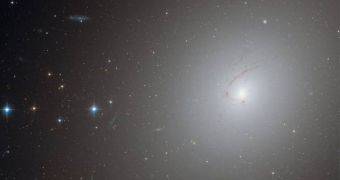Astronomers recently snapped an interesting picture of a very peculiar galaxy, called NGC 4696. The structure contains numerous outstanding features, and experts have a lot to go on in their studies.
The team that conducted the observations used the Hubble Space Telescope to capture the image.
It was obtained by combining a 5,440-second exposure photograph collected in a blue filter with another picture of the exact same location, but taken after a 2,320-second exposure through a near-infrared filter.
The thing that stands out the most about the cosmic structure is its external appearance, which features a hook-like filament of cosmic dust.
This particular formation is enormous in size, spanning an estimated 30,000 light-years, according to the researchers behind the investigation.
The galaxy is called NGC 4696, and it has been classified as an elliptical galaxy. It has lost the ability to produce new, blue stars a long time ago.
This is generally what happens to such galaxies. They quickly exhaust their own supply of gas, and are only to produce new cosmic fireballs afterward if they collide with other galaxies.
Many astronomers believe that elliptical galaxies are produced when spiral galaxies collide with each other, giving birth to the ball of light the former are famous for.
As such, stellar formation only takes place for a limited amount of time, until the hydrogen gas supplies in both colliding galaxies are exhausted.
But NGC 4696 is different because of the dust lane scarring its surface. The feature is visible clearly in the new Hubble image, as are strange thin filaments of ionized hydrogen too.
These particular structures only become visible when the galaxy is viewed in certain wavelengths.
But the peculiarities the galaxy exhibits don't stop here. When viewed in X-rays, a supermassive black hole becomes apparent at its core.
The dark behemoth is releasing X-rays from its poles at nearly the speed of light, producing shock waves so massive, that they literally punch holes through the entire galaxy.
Hubble, which used its Advanced Camera for Surveys (ACS) for the new observations, cannot see the jets, but the Chandra X-ray Observatory definitely can, Space reports.
Follow me on Twitter @TudorVieru

 14 DAY TRIAL //
14 DAY TRIAL //